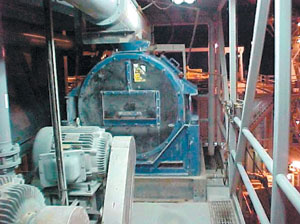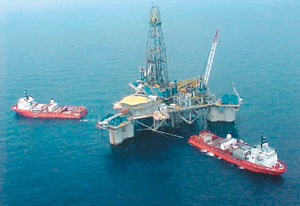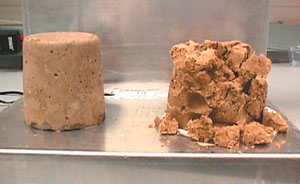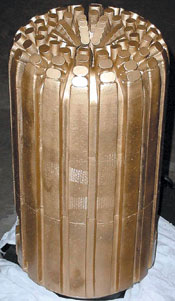|
Jan.
2002 Vol. 223 No. 1
Feature Article
|
DEEPWATER TECHNOLOGY
Current offshore performance highlights
 n
the presentation titled "Delivering today," Don Jacobsen overviewed SEPCo’s rig operations,
noting contributions to safety, and health / safety / environment (HSE) issues. He discussed Shell’s
proprietary Drilling the Limit (DTL) program, comparative performance, and results / opportunities identified
at NaKika field. He then discussed Shell’s goals and progress in improving reservoir / well performance
in both offshore shelf areas and deeper waters, by describing successes in: 1) subsea completions (record
stimulations, and drilling through depleted zones to deeper targets); 2) extended reach drilling (ERD) (new
technologies and results); 3) HPHT challenges / opportunities; and 4) drilling for deep gas (areas of
opportunity, new bit designs, completion issues). n
the presentation titled "Delivering today," Don Jacobsen overviewed SEPCo’s rig operations,
noting contributions to safety, and health / safety / environment (HSE) issues. He discussed Shell’s
proprietary Drilling the Limit (DTL) program, comparative performance, and results / opportunities identified
at NaKika field. He then discussed Shell’s goals and progress in improving reservoir / well performance
in both offshore shelf areas and deeper waters, by describing successes in: 1) subsea completions (record
stimulations, and drilling through depleted zones to deeper targets); 2) extended reach drilling (ERD) (new
technologies and results); 3) HPHT challenges / opportunities; and 4) drilling for deep gas (areas of
opportunity, new bit designs, completion issues).
Offshore in the U.S. deep water, in mid-November SEPCo
had five deepwater floating rigs under contract; five platform rigs operating on TLPs; two HPHT jackups
working; and three active platform workover / sidetrack wells. It had drilled 19 new wells, completed 17
re-entry sidetracks, done 26 new completions (nine subsea), plus 14 recompletions / workovers and 16 P&A
operations.
HSE issues. HSE has received highest priority,
with notable success in accident reductions on rigs. Dedicated HSE staffs are on all rigs, and extensive
training is given to contractor staffs. HSE cases are developed for all rigs, including complete
asset-integrity assessments. And wellness programs are in place on most offshore rigs.
Shell is pursuing proactive work with the EPA on new
discharge requirements for synthetic, oil-based muds. These efforts have been recognized – the ISO 14001
certification of environmental elements of the HSE program was awarded in June. And the company holds
best-in-class regulatory (INC’s and PNC’s), and environmental performance (spills in the Gulf of
Mexico).
SEPCo uses environmentally friendly synthetic drilling
fluids. It was the first operator to use cuttings dryers in the GOM – now a requirement for all
operators, Fig. 1. It provided most of the environmental data for EPA’s new rules coming out on discharge
of synthetic-based drill cuttings.
 |
|
Fig. 1. Cuttings drying centrifuges
installed on all SEPCo Gulf of Mexico rigs minimize environmental impact by reducing synthetic fluid
on cuttings to 2 – 3% from 12 – 15%. |
|
Drilling the Limit. Shell’s DTL program
has paid off with tangible results. In three years, drilling performance – measured in average days/1,000
ft below the mudline for conventional wells – has dropped from 3.7 in 1999, to 1.9 in 2001. And, compared
to competitive operator performance on frontier exploration wells, Shell’s days/1,000 ft were, on
average, 50% less for the deep, Miocene inverted basins and 38% less for the Miocene sub-salt wells.
DTL results in the NaKika development program have
helped deliver the first two wells in 56 days for $24 million, vs. the AFE which called for 109 days and $34
million. Twenty-eight technical opportunities were identified at NaKika, including: a mini-derrick / bucking
machine (added at NaKika); openhole sidetracks using set-able spot; rig move with BOP suspended; 13-5/8-in.
production casing; and dedicated logistical support. Future innovations include drilling with casing,
multilaterals and subsea pumping.
Optimizing completions, recompletions. Jacobsen
broadened the scope somewhat beyond "deep water" to discuss Shell’s progress in improving
quality of well performance in optimizing production and reservoir recovery. For starters, he noted the Crosby
A-5 world’s record frac-pack job done with the
Paul Romano semi through 4-1/2-in. tubing, Fig. 2. The job used 258,000 lb of proppant at 45 bpm and
13,000 psi pump pressure, requiring 14,000 hhp. Such jobs have produced wells yielding up to 25,000 bopd, per
well.
 |
|
Fig. 2. World-record frac pack from
Paul Romano semi used 258,000 lb of proppant at 45 bpm. Such stimulations help create
25,000-bopd per well rates. |
|
Shell has also found a way to access deeper reservoirs
in maturing assets below substantially depleted zones. These under-saturated, high-permeability formations can
be traps for lost circulation and problem drilling. Shell has developed a special resin fluid that strengthens
weak, depleted rocks to allow drill-through, Fig. 3. The Ursa A-11 was recently drilled through a 6,000-psi
depleted sand without affecting production from the nearby A-6 horizontal, 30,000-bopd producer.
 |
|
Fig. 3. Shell’s special resin
fluid pill changes depleted, high-permeability sands, right, to high-strength, zero-permeability rock,
left, to permit safe drill-through to deeper payzones. |
|
Extended-reach drilling, HPHT wells. Shell
makes extensive use of ERD in development well drilling, notably by extending subsea- and TLP-drilled wells to
lengths of five miles or more at TVDs of 15,000 ft to over 20,000 ft (BRT). And these wells maintain a large
diameter at TD (10-5/8-in.) for optimum production rates.
Applying barite sag control is one key tool used for
Shell’s ERDs. A problem in high-angle wells, barite settling may trigger loss of hole or well control.
SEPCo and its suppliers have developed special fluid formulations, monitoring techniques and drilling
practices to control the problem.
As proof that the program works, the Ursa TLP has three
wells with over-five-mile MDs, and the longest GOM platform well, at 30,100 ft. One Ursa well produced a
record 49.7 Mboepd; 23 MMbo was produced in two years from a single well; and six wells produced an average
36.6 Mboepd, per well.
 |
|
Fig. 4. Impregnated diamond/TSP bits
have helped achieve record runs in SEPCo’s deep gas drilling program in Mobile Bay. Photo
(courtesy of Hughes Christensen) illustrates a 9-1/2-in. Hedgehog bit. |
|
High-pressure, high-temperature wells are not well
publicized in the U.S. Gulf, but Jacobsen noted them as a relatively new target for potential gas reservoirs,
particularly on the Shelf area. Starting with SEPCo examples from the 1970s, an onshore Mississippi well had
22,000-psi BHP and 405°F BHT, with 39% H2S; and a Picaroon-area well from the 1980s on the
Shelf had 15,000 psi with 360°F and 9 ppm H2S. Four more offshore examples displayed BHPs
ranging from 13,450 – 18,000 psi, with 385 – 450°F BHTs and 1.5 – 100 ppm H2S.
Deep gas drilling. Jacobsen concluded his
presentation with a discussion of deep gas, noting that this has a huge scope for potential development.
Drilling results from the Alex JD-1 well showed that the
Chiles Magellan jackup drilled a well to 17,797 ft and landed a 9-5/8-in. liner in 110 days, 10 days
short of the AFE.
Some of Shell’s deep gas drilling improvements
include 12-3/4-in. and 9-1/2-in. high-performance motors; "straight hole" directional drilling;
oil-based mud and coolers for high BHTs; strict equivalent circulation density (ECD) control; and use of
impregnated diamond / TSP bits, as shown in Fig. 4.
Deep gas completions, however, remain challenging due
to high flowing temperatures, up to 350°F, and flowrates to 130 MMcfd or more, which produce wellhead
equipment / tubular stresses. Completion issues noted include: limited sources of heavy-wall, sour-grade
C-90/C-100 casing – a problem due to import tariffs on Japanese-mill sources and lack of domestic
technical capacity; CRA materials are difficult to manufacture; and QC problems have caused failure. Further,
high production rates increase wellhead temperatures, as noted. 

 |
Shell’s
deepwater program: A broad-based technology commitment |
 |
Don Jacobsen,
Manager, Drilling & Completions, Shell Exploration & Production Co. (SEPCo), New Orleans; |
 |
Paul Goodfellow,
Drilling & Completions Operations Manager, Shell International Exploration E&P Inc., New Orleans;
|
 |
Ken Dupal, Sr.
Staff Drilling Engineer, SEPCo, New Orleans; and |
 |
Graham Brander,
Sr. Drilling Engineer, Shell International E&P Inc., Houston. Overviews of their presentations follow.
 |
|






